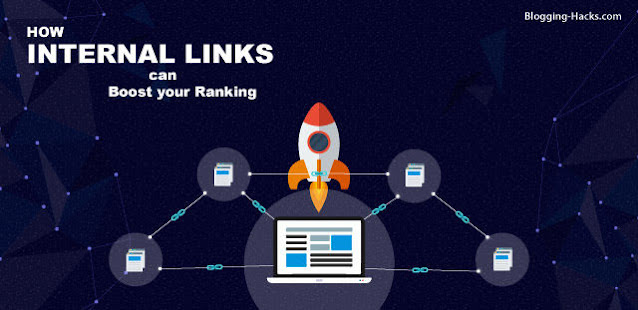
Internal links play a significant role in link building exercise. Within this post, we will have a look at what is internal linking and how internal links can boost your ranking.
So, what are internal links?
Links which points to the links within the same website are called internal links. In other words, any links on a particular domain (mysite.com/home-page.html) pointing to another link (mysite.com/contact-us.html) on the same domain are the internal links of that domain.
The links placed within the sidebar, top menu bars, footer and even in breadcrumbs are all examples of the internal links. These links help Google understand the hierarchical structure of your blog. They make navigation and access to your blog easy and faster.
However, links placed within the actual content part of your blog serve a more meaningful purpose. In the following story, we will see how these internal links can boost your ranking and Page Authority (PA) of your blog post.
Let's have a look at benefits offered by internal linking to boost your blog SEO.

Let's understand what is PA first. Page Authority is the metric which is developed by Moz to foretell how well a specific page will perform in search engine ranking. It uses score 0-100 to rate the performance of a web page. 0 being the low and 100 being the higher chance to rank in SERP.
Naturally, your blog will have few blog posts with higher PA and few with the low PA. Internal links can help to distribute this page authority with the rest of the pages with low PA.
We can use the popularity of a particular blog post which drives more traffic to your website to promote other blog articles on your blog. This will boost the PA of all pages on the site.
This concept of passing PA from one link to another is called "Link Juice" or "Link Equity". Though while passing link juice through internal links, it should be ensured that there is a contextual reference to the topic. This way the user will stay focused on the topic, be more engaged with the site and will reduce the bounce rate of the site.
2. Internal linking increases user engagement
One of the main reason behind the effective working of the internal links is that they are context based.
As internal links tend to stick with the topic, a user is more likely to explore more content on the site. Internal links not only provide further reading options to readers but also reduces bounce rates.
Most of the visitors don't pay attention to the links placed within sidebars, menu bars or even related links section.
However, the righteous use of internal linking within the content-oriented blog post will ensure your visitors to click around, spend more time reading other articles and go deeper in the site.
Since internal links are more co-relevant to the topic, the user is more like to persuade them. For instance, we are discussing how internal links can boost the ranking of your blog. If I share a link to the post on 13 On-Page SEO techniques for better ranking, then there are good chances to get it clicked than the links in the navigational bar.
3. Internal links define site structure
Internal links, be it navigational links, menu-bar links or footer links helps Google understand the structure of your site. Along with the structure, they also establish the hierarchy of the site. It let Google understand which are high authority blog posts from the rest of the blog posts.
Having that said, it is not possible to add all links in navigation or menu bars. The contextual links placed within the blog post can also serve this purpose. Besides that, there are several benefits of placing internal links within the blog post.
4. Improves ranking for certain keywords
Hyperlinks, whether they are the internal or external help to improve the ranking of the keywords. Google gives extra weight to the anchor text being used in the link. Hence, internal links give us a chance to promote the keywords from your blog.
With the help of internal links, the author can use important keywords to tell a search engine that, these keywords convey special meaning for the blog post being hyperlinked. Have a look at below hyperlink:
Off-Page SEO Techniques
I have purposely used Off-Page SEO Techniques keyword to add extra weight and associate these keywords with the blog post on off-page SEO techniques.
When Google crawler crawls your web pages, it associates these keywords used in anchor text with the hyperlinked blog posts. Thus and so, allowing blog author to improve the ranking of the keywords.
The author does not have a choice to choose the keywords being used in the external link. However, in an internal link, all important keywords, which matters for your blog can be used in well established contextual writing.
Best practices for adding internal links:
1. Add internal links in the flow of the content:
Generally, we add links to several articles in the sidebar and menu sections for easy site navigation. However, if you add internal links within the flow of the content, it would be more beneficial from the SEO perspective. Since there are more chances a user could notice it and possibly follow it for further reading.
2. Do not place irrelevant links until it's necessary: Internal links should be added only to contextual places. Adding irrelevant links wouldn't please your readers as well as Google.
3. Add links on popular pages linking it to non-performing pages: Use your popular blog posts to link other important posts on your blog. Your highly ranked blog posts can help to distribute link juice across your blog. This will help increase the ranking of the non-popular web pages.
4. Use targeted keywords in anchor text: Author can use targeted keywords to establish a connection between the post and keywords being used in the anchor text. Google will come to know that your blog post hosts information relating to the keywords.
5. Use alternate keywords in anchor text for the same link: A particular blog post can be linked through the variety of the linking text. Use a combination of alternative keywords to link to your blog post.
6. Link ratio: A linking ratio should be maintained between the internal links and external links. Also, there should be a limitation on the number of links being used as to the length of the overall blog post.
Conclusion:
We had a look at what is internal linking. We discussed the benefits of internal linking and how internal links can boost your blog ranking.
Internal links can help to boost PA of non-performing pages by linking them to popular pages. Internal links also increase user engagement resulting in a lower bounce rate and hence increasing the conversion rate and revenue.
Internal links help to define the site structure and hierarchy of the web pages. It also helps to improve the ranking of certain keywords used in the anchor text.
Furthermore, we had a look at the best practices for adding internal links to boost your blog ranking.
Please share what is your story on the topic. Also, share this blog post on your Facebook, Twitter, Pinterest, and Instagram.
1. Add internal links in the flow of the content:
Generally, we add links to several articles in the sidebar and menu sections for easy site navigation. However, if you add internal links within the flow of the content, it would be more beneficial from the SEO perspective. Since there are more chances a user could notice it and possibly follow it for further reading.
2. Do not place irrelevant links until it's necessary: Internal links should be added only to contextual places. Adding irrelevant links wouldn't please your readers as well as Google.
3. Add links on popular pages linking it to non-performing pages: Use your popular blog posts to link other important posts on your blog. Your highly ranked blog posts can help to distribute link juice across your blog. This will help increase the ranking of the non-popular web pages.
4. Use targeted keywords in anchor text: Author can use targeted keywords to establish a connection between the post and keywords being used in the anchor text. Google will come to know that your blog post hosts information relating to the keywords.
5. Use alternate keywords in anchor text for the same link: A particular blog post can be linked through the variety of the linking text. Use a combination of alternative keywords to link to your blog post.
6. Link ratio: A linking ratio should be maintained between the internal links and external links. Also, there should be a limitation on the number of links being used as to the length of the overall blog post.
Conclusion:
We had a look at what is internal linking. We discussed the benefits of internal linking and how internal links can boost your blog ranking.
Internal links can help to boost PA of non-performing pages by linking them to popular pages. Internal links also increase user engagement resulting in a lower bounce rate and hence increasing the conversion rate and revenue.
Internal links help to define the site structure and hierarchy of the web pages. It also helps to improve the ranking of certain keywords used in the anchor text.
Furthermore, we had a look at the best practices for adding internal links to boost your blog ranking.
Please share what is your story on the topic. Also, share this blog post on your Facebook, Twitter, Pinterest, and Instagram.












2 comments
Great information, really helpful :)
ReplyDeleteThank you Asking Minds!
DeleteGlad you liked it! :)